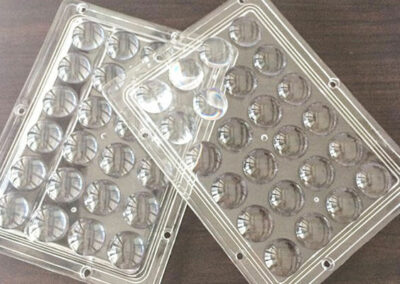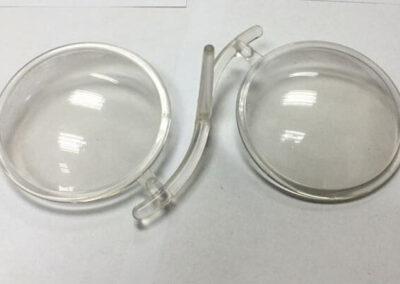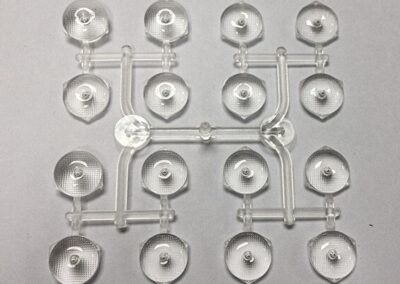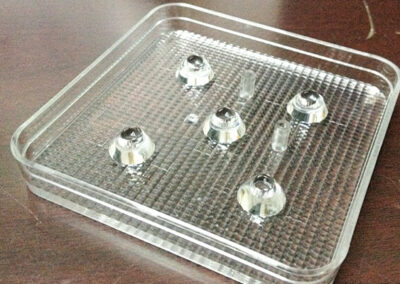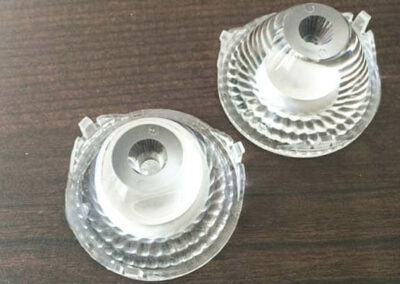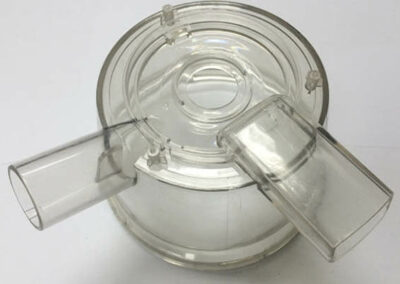Polycarbonate Injection Molding and Polycarbonate Thermoforming
Polycarbonate (PC) is a high-quality and versatile thermoplastic that is commonly processed using two methods: Polycarbonate injection molding and Polycarbonate thermoforming. Before we start making products, let’s first understand the differences between these two methods: Polycarbonate injection molding is suitable for mass production and high-precision plastic parts, while polycarbonate thermoforming is more suitable for manufacturing large, complex and low-volume production plastic parts. Choosing the right processing technology is critical to the success of your product. By contacting Sungplastic’s professional team, we can help you choose the processing method that best suits your needs, increase production efficiency and reduce your costs.
What Is Polycarbonate(PC)?
Polycarbonate (PC) is a high-performance thermoplastic widely used in plastic manufacturing. It has transparent properties that spread light naturally like glass. Polycarbonate is composed of methyl and phenyl groups that form tightly bound linear chains that enhance polycarbonate’s heat resistance. In addition, polycarbonate also exhibits excellent impact resistance, making it ideal for applications requiring safety and durability, and is often used as a replacement for glass. Due to its versatile properties, polycarbonate is used in a wide range of industries. Its lightness, strength, heat resistance and flame retardancy make it a prime choice for a variety of applications where durability and safety are critical.
Polycarbonate Injection Molding
Polycarbonate injection molding represents a state-of-the-art manufacturing process tailored for crafting small, solid plastics with intricate detailing. This technique involves the transformation of polycarbonate plastic from its solid state into a liquid form, which is then injected into a specially designed, double-sided mold. The result is a precisely molded plastic component that meets stringent quality standards.
One of the distinctive features of polycarbonate injection molding is its ability to produce highly detailed pieces with exceptional accuracy and consistency. This level of precision minimizes waste and rework, contributing to overall cost savings and enhanced product quality. Polycarbonate injection molding makes it an ideal choice for applications where intricate designs, fine textures, or complex geometries are essential.
While it’s true that the initial investment in tooling for polycarbonate molding can be higher compared to other manufacturing methods like thermoforming, it offers significant advantages over the long term, especially for ongoing or large-scale production. Once the mold is meticulously designed and created, it can be employed repeatedly for as long as needed. This means that for projects with continuous orders or a requirement for substantial quantities of plastic parts, the per-unit cost of polycarbonate molding becomes increasingly cost-effective and economically viable.
Polycarbonate Thermoforming
Polycarbonate thermoforming is a manufacturing process that entails heating the plastic material until it becomes soft and pliable, allowing it to be shaped around a custom mold or tool to achieve a desired form. Depending on the specific requirements of the product, three distinct thermoforming methods can be employed:
Vacuum Forming:
Vacuum forming is the most fundamental technique, involving the use of a powerful vacuum to create a tight bond between the plastic sheet and the mold while extracting excess air. Although it may not be suitable for producing intricate or sharply detailed parts, vacuum forming is highly effective for crafting large, curved components like windshields and windows.
Pressure Forming:
Pressure forming is utilized for larger plastic pieces that demand sharp edges and intricate details that vacuum forming cannot achieve. In certain cases, it serves as a cost-effective alternative to injection molding. In this method, once the plastic sheet is fitted onto the mold, highly pressurized air is applied to firmly press the plastic against the mold, resulting in the desired shape, such as headlamp bezels for automobiles.
Twin-Sheet Forming:
Twin-sheet forming is the most complex of the polycarbonate thermoforming techniques and requires a high level of precision and attention to detail. Two plastic sheets are simultaneously heated and molded, and then carefully aligned and fused together. To maintain product integrity, pressure points must be meticulously matched. Twin-sheet forming is typically employed for producing double-walled or hollow products.
Polycarbonate Applications in Various Industries
Polycarbonate is an engineering plastic with excellent mechanical properties, high strength and durability. Polycarbonate injection molding and thermoforming are two common processing methods. They allow the excellent properties of polycarbonate to be fully utilized, providing a variety of application options to meet the needs of different industries for high quality, durability and precision parts. Below are the different industries where polycarbonate injection molding and polycarbonate thermoforming have their respective applications.
Applications of Polycarbonate Injection Molding:
-
- Electronics Industry: Polycarbonate injection molding is used to make housings, connectors, panels and lenses for electronic devices because of its high transparency, electrical insulation properties and high temperature resistance.
- Automotive Industry: Polycarbonate injection molding enables the manufacture of complex components such as dashboards, headlight lenses, interior trim parts and buttons.
- Medical Devices: Polycarbonate injection molding is used to make housings, instrument parts, and clear covers for medical devices because it is biocompatible and chemically resistant.
- Consumer Poducts: Polycarbonate injection molding is widely used to make eyeglass lenses, mobile phone screens, CD/DVD discs and household products because of its durability and high transparency.
Applications of Polycarbonate Thermoforming:
-
- Aerospace: Thermoforming of polycarbonate is used to create clear cladding, windows and portholes on aircraft and spacecraft because of its ability to withstand extreme air pressure and temperature changes.
- Construction Industry: Thermoforming of polycarbonate is used in the manufacture of building materials such as daylight hoods, skylights and sunshades because it is weather-resistant and highly transparent.
- Packaging Industry: Polycarbonate thermoforming can be used to produce highly transparent and rigid packaging containers, such as food boxes, cosmetic boxes and display boxes.
Contact Us for Custom Polycarbonate Parts
After the previous detailed introduction, I believe you have a preliminary understanding of the thermoplastic material polycarbonate. However, which one ultimately chooses polycarbonate injection molding or thermoforming? The decision depends primarily on several factors: part complexity, manufacturing cost, production volume, and time requirements. Choosing the most suitable molding method is crucial to ensure the best balance of performance, quality and cost-effectiveness in the final product.
Sungplastic is an experienced plastic parts manufacturer, we specialize in providing customized parts manufacturing services to meet our customers’ unique design and manufacturing needs. We offer a variety of material options including polycarbonate, ABS, acrylic and more. Whether you require polycarbonate injection molding or thermoforming, we will be flexible according to your specific requirements and project size, and ensure on-time delivery and excellent after-sales service. Contact Sungplastic now to start our journey of cooperation.
Get a free quote and design analysis today.
We’ll reply to you within 6 working hours.
We respect your privacy.
+86 139 2927 4777 (WhatsApp, Wechat)

